This post may contain affiliate links. The Review Wire may collect a share of sales if you decide to shop from them. Please see my full disclosure policy for details.
The annual tradition of decorating the Christmas tree has begun. The idea of hauling a real tree home, dealing with all the fallen needles, and figuring out how to dispose of it after the holidays is too much. This is why I have always stuck with an artificial Christmas tree – they are not only convenient but reusable.
Choosing the perfect artificial tree isn’t as simple as picking the first one you see. It’s about finding a tree that fits your space and matches your style, budget, and practical needs. Whether you’re a first-time buyer or looking to upgrade your artificial tree, this guide covers everything you need to know.
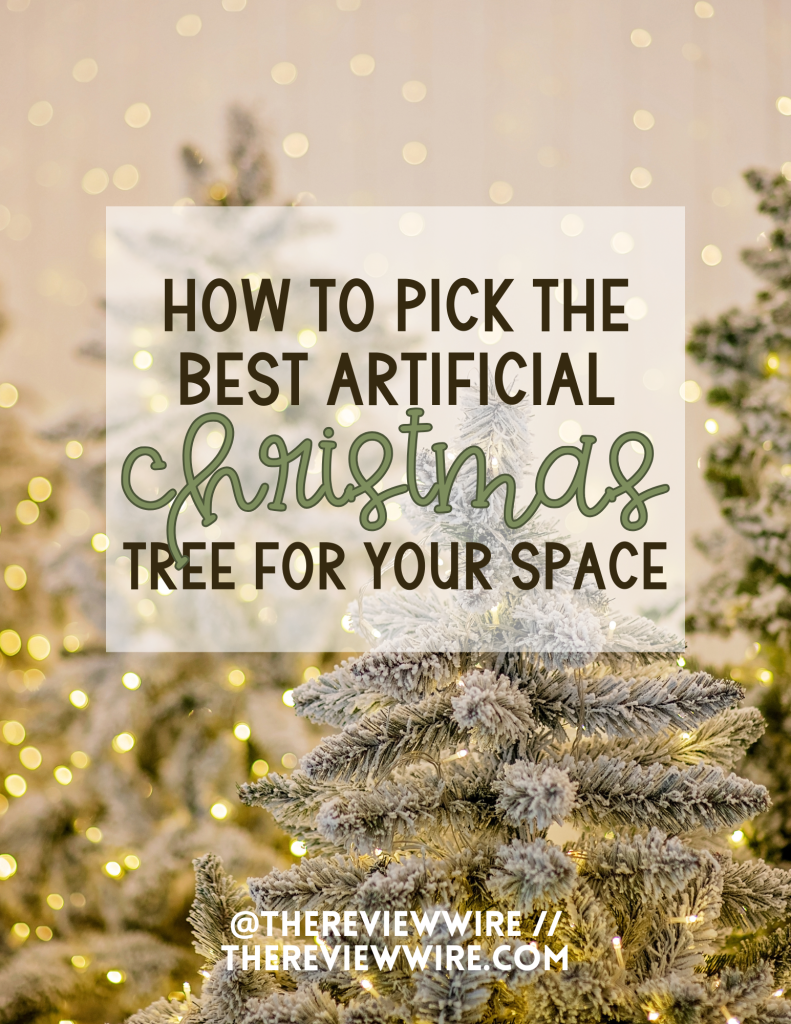
Understanding Your Space: Picking the Best Artificial Christmas Tree
Before buying an artificial Christmas tree, you need to understand your space. You don’t want a tree that’s too tall for your ceiling or too wide for your living room corner. Here are some considerations for finding the perfect fit.
Assessing Tree Size: Height and Width Considerations
When it comes to artificial Christmas trees, size matters. Here’s how to get it right:
Height: Start by measuring your ceiling height. Generally, leave at least 6 inches between the top of your tree and the ceiling. This space allows for a tree topper and prevents the tree from looking cramped.
For example, if you have standard 8-foot ceilings, a 7.5-foot tree would be ideal. For those with vaulted ceilings, you might opt for a majestic nine or 10-foot tree to make a grand statement.
Width: Remember, the width matters too! Measure the width of your intended tree spot. A slim or pencil tree might be perfect for a cozy apartment corner, while a full-width tree could be the showstopper in a spacious living room.
Evaluating Space: Fitting the Best Artificial Christmas Tree in Your Home
Now that you’ve got your measurements, it’s time to evaluate your space.
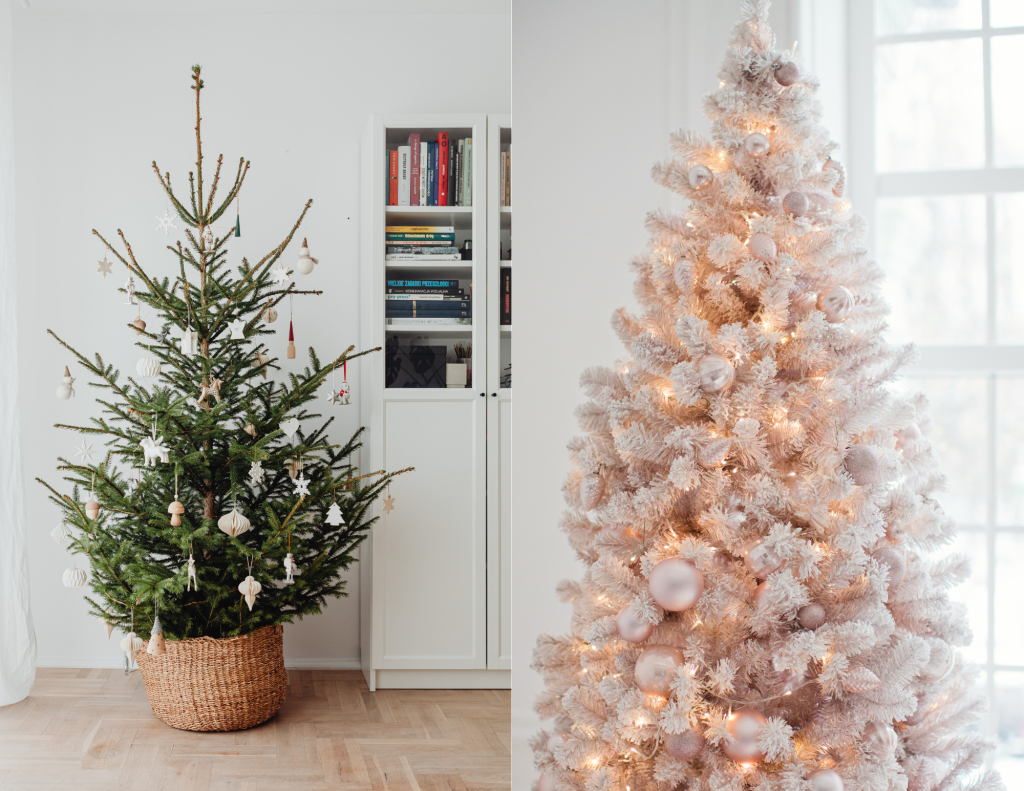
Room layout: Think about foot traffic. Will your tree obstruct walkways or doorways? Ensure there’s enough space to move around comfortably.
Furniture placement: Your tree should complement, not compete with, your existing furniture. Consider how it will look from different angles in the room.
Viewing distance: A fuller, more detailed tree might be worth the investment if your tree will be viewed primarily from across a large room. For closer quarters, a simpler tree could suffice.
Multi-purpose spaces: If you’re placing your tree in a room that serves multiple functions (like a living room/dining room combo), ensure it doesn’t interfere with the room’s other uses.
Remember, the perfect tree isn’t just about looks – it’s about how it fits into your life and your home.
Types of Artificial Christmas Trees: Choosing Based on Needle Tips
Not all Christmas tree needles are created equal. The type of needle tips you choose can dramatically affect your tree’s overall look and feel. There are three main needle categories: classic, realistic, and premium needle tips.
Classic Needle Tips: Traditional Appearance
Classic needle tips are the OGs of artificial Christmas trees. Their flat, paper-like appearance characterizes them, and they are often made from PVC. These trees are usually the most budget-friendly option with a simple design that can withstand years of use and storage.
While they may not fool anyone into thinking they’re real, classic needle tips have a charm all their own. They’re perfect for those who appreciate a more obviously artificial look or are decorating on a tight budget.
Realistic Needle Tips: Mimicking Real Trees
Realistic needle tips are designed to closely resemble the needles of actual pine trees. They’re typically made from PE (polyethylene) and are molded to mimic real needles’ structure and color variations. These trees can be mistaken for the real thing from a distance as the needles have a more three-dimensional feel, adding depth to your tree. You can find realistic tips mimicking different kinds of pine, spruce, or fir.
If you love the look of a real tree but prefer the convenience of an artificial one, realistic needle tips offer the best of both worlds. They’re ideal for those who want to maintain a natural aesthetic without the mess of a real tree.
Premium Needle Tips: High-End Options for Luxurious Looks
Premium needle tips represent the crème de la crème of artificial Christmas trees. These often combine the best features of realistic tips with additional enhancements for an ultra-lifelike appearance. Many premium trees combine different needle types to create depth and realism, and the tips often include subtle color gradations to mimic the natural variations of real pine needles. The overall branch design is often more sophisticated, replicating the growth patterns of real trees.
Premium needle tips are for those who want the absolute best in artificial trees. While they come with a higher price tag, they offer unparalleled realism and can become a stunning centerpiece in your holiday decor.
Choosing Tree Colors: Aesthetic Compatibility with Your Decor
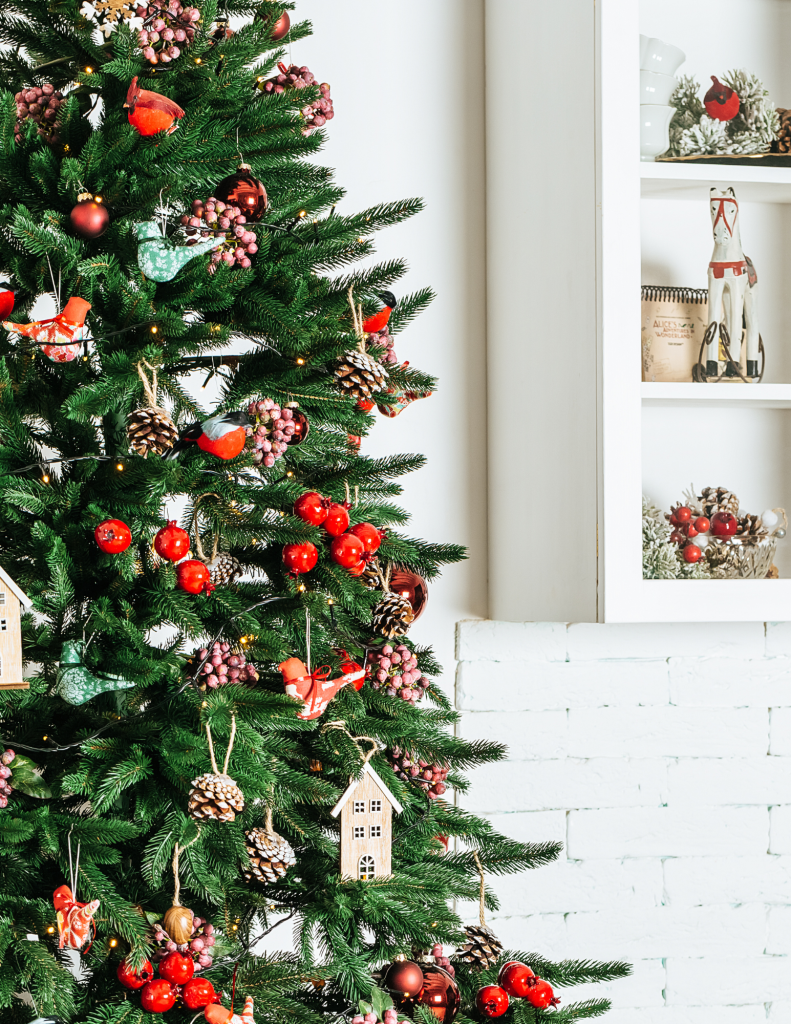
Trees come in a rainbow of colors to suit any decor style or personal preference. Here are several of the most popular color options.
Traditional Green Trees: Timeless Choice
Green artificial trees remain the most popular choice, and for good reason. They offer a classic look that never goes out of style. Green trees complement virtually any color scheme or decorating style if you’re after a natural look.
Pro tip: Look for trees with varying shades of green needles for a more realistic appearance. Some high-end models even incorporate brown “branches” to mimic real tree bark.
Flocked Trees: Adding Winter Wonderland Vibes
Flocked trees are dusted with a white, snow-like material to create the illusion of a tree freshly blanketed in snow. Flocked trees are perfect for creating a winter wonderland feel indoors, as the white flocking adds depth and interest to your tree, and ornaments pop beautifully against the snowy background.
Colored Trees: Making a Bold Statement
For those who dare to be different, colored artificial trees offer a fun and festive alternative to traditional green. Popular color choices and their vibes:
- White: Creates a clean, modern look. Perfect for minimalist or Scandinavian-inspired decor.
- Silver or Gold: Adds a touch of glamour and elegance. Ideal for a luxe holiday theme.
- Pink: Playful and unexpected. Great for a retro or kitsch Christmas vibe.
- Blue: Cool and calming. Works well with coastal or winter-themed decor.
- Black: Dramatic and sophisticated. A unique backdrop for colorful ornaments.
When choosing a colored tree, consider your decor and the mood you want to create. A pink tree might be perfect for a fun, retro-inspired living room, while a sleek white tree could complement a modern, minimalist space.
Remember, your tree color sets the tone for your entire holiday decor scheme. Whether you stick with classic green or go bold with a vibrant hue, choose a color that resonates with your style.
Lighting Options: Picking the Best Artificial Christmas Tree Lights
Lights are the twinkling soul of any Christmas tree. They create that magical ambiance that makes you want to curl up with a good book and never leave your living room. But when it comes to artificial trees, you have some decisions.
Pre-lit Trees vs. Unlit Trees: Benefits and Drawbacks
The great debate: to pre-lit or not to pre-lit?
Pre-lit Trees:
- Pros: Convenience (no tangled lights!), professional-looking light distribution, time-saving setup.
- Cons: Limited control over light type/color, potential for light failure over time, and higher upfront costs.
Unlit Trees:
- Pros: Full control over lighting, easier to replace lights, typically more affordable.
- Cons: Time-consuming setup, potential for uneven light distribution.
Pro tip: If you change your tree theme more often than your socks, an unlit tree might be your best bet for maximum flexibility.
Choosing Colors of Lights for Your Tree
When it comes to light colors, you’ve got options…
- Warm White: Creates a cozy, traditional ambiance. Perfect for that “chestnuts roasting on an open fire” vibe.
- Cool White: Offers a crisp, modern look. It’s ideal for a winter wonderland theme.
- Multicolor: Brings a playful, festive energy. Great for families with kids or the young at heart.
- Single-color (like all blue or red): This makes a bold statement and works well for themed decor.
Remember, the color of your light can dramatically affect the overall look of your tree. A tree with warm white lights will feel completely different from the same tree with multicolored lights.
Smart Lighting Options: Modern Features in Christmas Trees
Smart lighting options are revolutionizing the way we light up our trees. Some cool features to look out for:
- Color-changing lights: Switch between colors or effects with a remote or smartphone app.
- Voice control: “Alexa, turn on the Christmas tree!” Need we say more?
- Programmable settings: Set schedules for your tree to light up and turn off automatically.
- Music sync: Some trees can sync their lights to your favorite holiday tunes.
Imagine impressing your guests by changing your tree’s color scheme to match their ugly Christmas sweaters.
Remember, at the end of the day, the best lights are the ones that make you smile when you plug them in. So choose what brings you joy, and let your tree shine bright!
Ease of Assembly: Finding the Best Artificial Christmas Tree for Convenient Setup
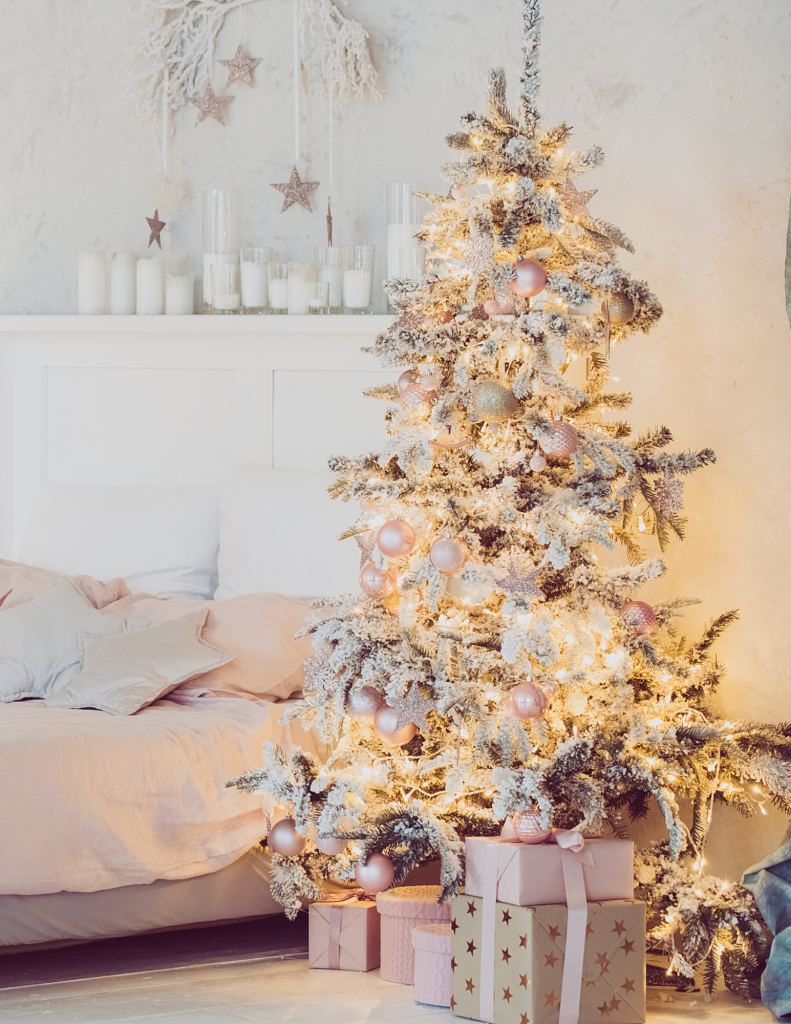
Nobody wants to spend hours wrestling with a Christmas tree when they could be sipping eggnog and watching “Elf” for the umpteenth time. That’s why ease of assembly is crucial when choosing your artificial tree.
Folding vs. Traditional Models: Which is Best?
When it comes to artificial trees, you generally have two main types: folding and traditional models.
Folding Models:
- Pros: Quick setup (often under 5 minutes), pre-attached branches, minimal storage space required.
- Cons: It can be more expensive, may have a less natural look, and has limited ability to adjust branch positions.
Traditional Models:
- Pros: More customizable, often more realistic-looking, typically less expensive.
- Cons: Longer setup time, require more storage space, can be fiddly to assemble.
Imagine this: It’s December 1st, and you’re eager to start decorating. With a folding tree, you could have it up before your hot chocolate finishes brewing. On the other hand, a traditional model might take the length of a holiday movie to set up, but you’ll have more control over its final shape.
When deciding between folding and traditional models, consider your priorities. Do you value speed and convenience above all? A folding tree might be your best bet. Are you a perfectionist who loves to tweak every branch? A traditional model could be more satisfying.
Storage Considerations: Picking the Best Artificial Christmas Tree for Easy Disassembly and Storage
As the holiday season winds down, the last thing you want is a wrestling match with your Christmas tree. Proper storage not only makes your life easier but also extends the life of your tree.
Best Practices for Storing Your Artificial Christmas Tree
Follow these tips to ensure your tree stays in tip-top shape for next year:
- Clean before storing: Give your tree a gentle dusting or vacuuming to remove debris or pet hair.
- Remove all decorations: Double-check for any lingering ornaments or tinsel.
- Compress the branches: Gently push the branches upward and inward, closer to the trunk. This reduces the tree’s overall size.
- Disassemble carefully: If your tree comes apart in sections, take it apart gently to avoid damaging connection points.
- Use proper storage containers: Invest in a tree storage bag or box. These protect your tree from dust, pests, and moisture.
- Store in a cool, dry place: Avoid areas prone to extreme temperatures or humidity, which can damage your tree over time.
Pro tip: Take a photo of your beautifully decorated tree before disassembling it. It’ll serve as inspiration (and a helpful guide) for next year’s decorating session!
Choosing Tree Sizes That Fit in Your Storage Space
When selecting your artificial tree, consider where you’ll store it for the other 11 months of the year. Here are some factors to keep in mind:
- Measure your storage space: Whether it’s a closet, attic, or under-bed area, know your dimensions before buying a tree.
- Consider collapsible trees: Some models are designed to compress significantly, making storage a breeze.
- Look for trees with removable sections. If space is tight, these can be stored in smaller, separate containers.
- Think vertical: If floor space is limited, consider a slimmer tree that can be stored upright.
Imagine this: You’ve fallen in love with a majestic 9-foot tree, only to realize it won’t fit through your attic hatch. Avoid this holiday heartbreak by planning ahead!
For those living in compact spaces, consider these creative storage solutions:
- Vacuum storage bags: These can compress your tree to a fraction of its size.
- Modular storage systems: These allow you to customize storage to fit your specific tree size and available space.
The perfect tree isn’t just about how it looks during the holidays—it’s also about how well it fits into your life year-round. Choosing a tree with storage in mind, you’ll save yourself future headaches and ensure your artificial tree remains a source of joy, not stress.
Budgeting for Your Tree: Picking the Best Artificial Christmas Tree Without Breaking the Bank
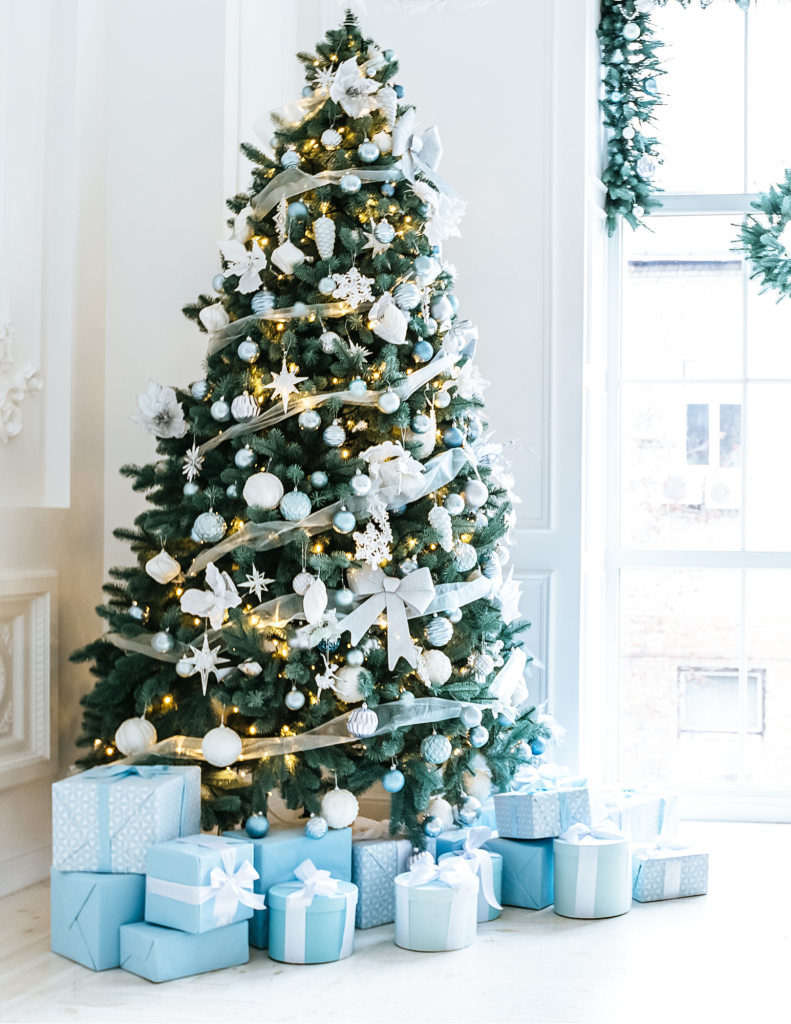
The holiday season can be expensive enough without dropping a small fortune on a Christmas tree. With some savvy shopping and insider tips, you can find a fantastic artificial tree that won’t leave your wallet feeling like the Grinch stole Christmas.
Quality vs. Price: Finding the Best Value
The old adage “you get what you pay for” often rings true when it comes to artificial Christmas trees. However, that doesn’t mean you need to max out your credit card for a quality tree. Here’s how to strike the right balance:
- Consider longevity: A higher-priced, high-quality tree might save you money in the long run if it lasts for many years.
- Look at the construction: Check for sturdy bases, durable branches, and well-made connections. These factors contribute to a tree’s lifespan.
- Assess the appearance: More expensive trees often look more realistic, but decide how important this is to you. A well-decorated, less expensive tree can still look stunning.
- Factor in features: Pre-lit trees or special features like snow-flocking might cost more upfront but save you time and additional purchases later.
Pro tip: Think of your tree as a per-year investment. A $300 tree that lasts 10 years is actually cheaper per year than a $100 tree you replace every 3 years!
Budget-Savvy Tips for Purchasing Your Tree
Ready to become a Christmas tree bargain hunter? Here are some tips to help you snag the best deal:
- Shop off-season: The best deals are often found in January or during summer sales. Yes, it requires planning ahead, but your wallet will thank you.
- Compare prices online: Use price comparison tools to find the best deals across multiple retailers.
- Look for package deals: Some retailers offer bundles that include lights, ornaments, or tree skirts, potentially saving you money on decorations.
- Consider last year’s models: Like cars, new tree models come out yearly. Last year’s models are often discounted but still fantastic.
- Check for coupons and cashback: Use browser extensions like Rakuten to find additional savings.
- Don’t overlook open-box or floor models: These can offer significant discounts on high-quality trees.
Imagine scoring a premium tree for half price just because you were savvy enough to shop in July.
Remember, being budget-conscious doesn’t mean settling for a Charlie Brown Christmas tree (unless that’s the look you’re going for). It’s about being smart with your money and finding the best value for your needs. Shop smart, compare options, and find that perfect balance of quality and affordability.
Think of your artificial tree as a long-term relationship. It’s going to be a part of your holiday celebrations for years to come. So, take your time, do your research, and don’t be afraid to invest a little more for quality if it means years of hassle-free Christmases.
Happy tree hunting!

Leave a Reply